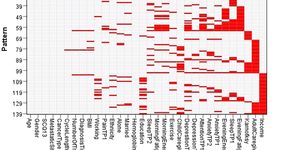Glioblastoma Affects Men Differently Than Women
It’s been established that men have slightly higher rates of cancer and a greater likelihood of dying from the disease. Researchers have now found molecular signatures in a deadly type of malignant brain tumor, glioblastoma, that are different in men and women, and may help show why there are gender differences in cancer rates and outcomes. The work has been reported in Science Translational Medicine. Learn more about cancer statistics from the video.
"It is our expectation that this study could have an immediate impact on the care of patients with glioblastoma and further research, as the findings indicate we should be stratifying male and female glioblastoma into risk groups and evaluating the effectiveness of treatment in a sex-specific manner," said the study co-senior author Joshua B. Rubin, MD, Ph.D., a Washington University professor of pediatrics and of neuroscience. "The biology of sex differences and its applications in medicine are highly relevant but almost always ignored aspects of personalized treatments."
Glioblastoma is a deadly brain cancer usually found in people over 50, and it kills about half of those impacted within 14 months of their diagnosis. Men get it about twice as frequently as women. The typical treatment is surgical removal of the tumor, then radiation and chemotherapy. Even that aggressive approach isn’t usually enough, and new tumor cells often replace the ones that have been removed within about six months. The therapy is, however, more effective for women than men.
The researchers looked to MRIs in a cancer research database to find out how rapidly glioblastomas were growing - the tumor growth velocity. "Basically, you can look at tumor growth velocity while patients are undergoing treatment and derive a value for how fast their tumors are growing," explained Rubin. "This gives you an opportunity to think more deeply about whether the drug you're giving a patient is actually helping."
The data, from 40 males and 23 females who had all gotten the standard treatment, showed similar tumor growth velocities. However, only women experienced a significant and steady decrease in tumor growth after they received the most common glioblastoma chemotherapy drug - temozolomide.
"The males did not respond as well, and we wanted to understand why, so we looked at the underlying genetics of patients' tumors," said Rubin.
To do so, the scientists turned to The Cancer Genome Atlas (TCGA) and used computational methods to find gene expression patterns in men and women that were similar. After finding genes that were differentially expressed, the researchers focused on molecular changes that corresponded to survival differences in men and women.
"We observed tremendous genetic sex differences in the tumors of glioblastoma patients that correlated with survival," said the co-senior author of the study Jingqin "Rosy" Luo, Ph.D., a Washington University associate professor of surgery in the Division of Public Health Sciences. "All evidence supports the need to define these distinctions and incorporate the sex differences into glioblastoma biology research and treatment."
Glioblastomas fell into ten distinct subtypes - five for men and five for women, with unique gene expression patterns and patient survival rates. Females in one cluster survived for about three years compared to one year in the other female clusters. Males in one cluster survived for about 18 months compared to about one year for other male clusters. The team then validated their findings in other datasets.
While sex differences are often connected to hormones, the team did not find that sex hormones made a direct contribution to the changes they saw between men and women. "The sex-specific genetic activity in glioblastoma is not dependent on the acute actions of circulating sex hormones as differences are evident across all stages of life,” noted Rubin.
"In a broader sense, I want our research to encourage people to think more about how diseases uniquely affect males and females, making it the norm and not the exception," Rubin added.
Sources: AAAS/Eurekalert! Via Washington University School of Medicine, National Cancer Institute, Science Translational Medicine








